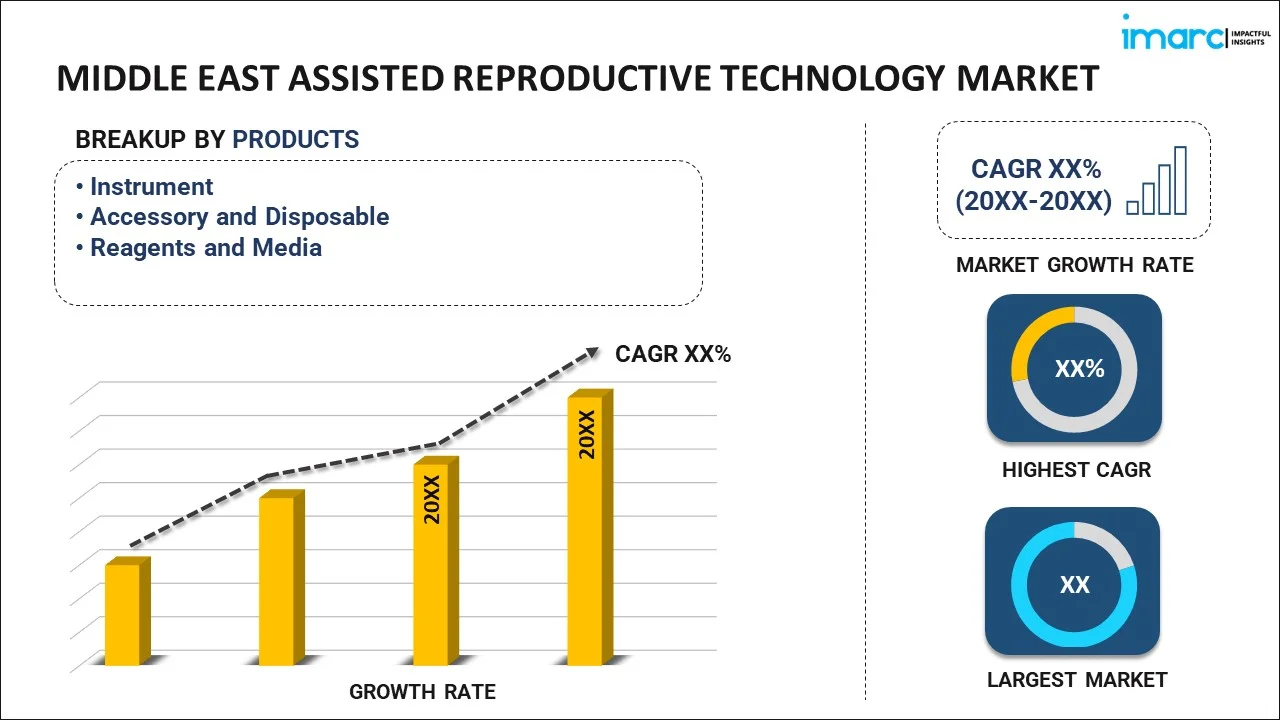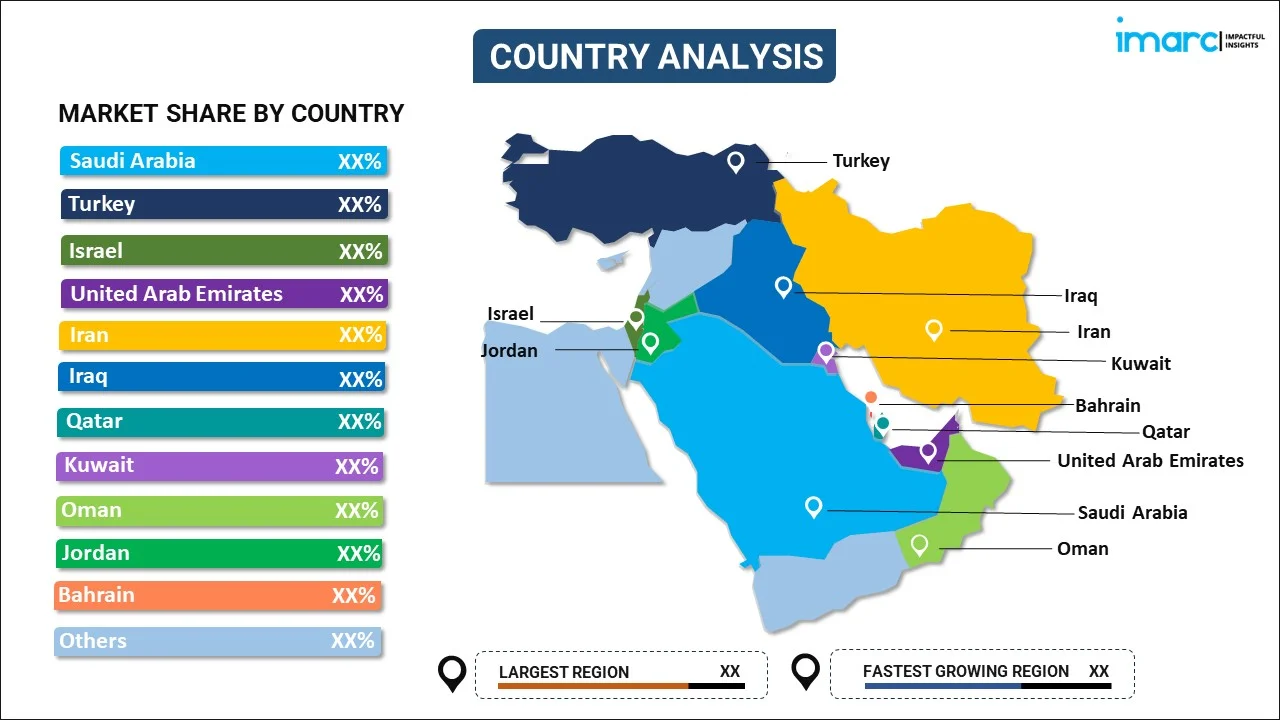
Middle East Assisted Reproductive Technology Market Report by Product (Instrument, Accessory and Disposable, Reagents and Media), Type (In-Vitro Fertilization (IVF), Artificial Insemination), End Use (Fertility Clinics and Other Facilities, Hospitals and Others), and Country 2025-2033
Market Overview:
Middle East assisted reproductive technology market size reached USD 1,609 Million in 2024. Looking forward, IMARC Group expects the market to reach USD 2,865 Million by 2033, exhibiting a growth rate (CAGR) of 6.62% during 2025-2033. The rising awareness among individuals towards advanced reproductive procedures, along with the flexible coverage offered by health insurance companies, is primarily driving the market growth.
|
Report Attribute
|
Key Statistics
|
|---|---|
|
Base Year
|
2024
|
|
Forecast Years
|
2025-2033
|
|
Historical Years
|
2019-2024
|
|
Market Size in 2024
|
USD 1,609 Million |
|
Market Forecast in 2033
|
USD 2,865 Million |
| Market Growth Rate 2025-2033 | 6.62% |
Assisted reproductive technology (ART) represents a groundbreaking field within the realm of reproductive medicine, offering innovative solutions to individuals and couples facing challenges in achieving pregnancy. In a world where fertility issues have become increasingly prevalent, ART stands at the forefront of scientific advancements, providing hope and avenues for those seeking to build families. This diverse range of medical procedures encompasses various techniques such as in vitro fertilization (IVF), intrauterine insemination (IUI), and gamete intrafallopian transfer (GIFT), among others. With its ability to address a spectrum of fertility-related issues, ART not only revolutionizes the conception process but also raises ethical, social, and legal considerations. As science and medicine continue to evolve, assisted reproductive technology remains a dynamic and evolving field, contributing to the ongoing dialogue surrounding reproductive health and family planning.
Middle East Assisted Reproductive Technology Market Trends:
The Middle East assisted reproductive technology market stands as a dynamic and evolving landscape, reflecting the region's growing awareness and acceptance of advanced reproductive solutions. Fueled by factors such as changing lifestyle patterns, delayed family planning, and a rising incidence of infertility, the demand for ART services has witnessed a noticeable upswing. Additionally, countries across the Middle East, including the United Arab Emirates, Saudi Arabia, and Qatar, have witnessed a surge in fertility clinics and treatment centers, catering to a diverse clientele seeking assistance in overcoming reproductive challenges, which is positively influencing the regional market. The expansion across the Middle East is not only driven by increased infertility rates but also by a cultural shift towards a more open discussion about fertility issues. Despite this progress, the Middle East ART market faces unique challenges, including cultural considerations, regulatory frameworks, and ethical concerns. As the region continues to navigate these complexities, the assisted reproductive technology market is positioned as an integral component of the broader conversation on healthcare and family planning.
Middle East Assisted Reproductive Technology Market Segmentation:
IMARC Group provides an analysis of the key trends in each segment of the market, along with forecasts at the regional and country levels for 2025-2033. Our report has categorized the market based on product, type, and end use.
Product Insights:

- Instrument
- Sperm Separation System
- Cryosystem
- Incubator
- Imaging System
- Ovum Aspiration Pump
- Cabinet
- Micromanipulator
- Laser Systems
- Others
- Accessory and Disposable
- Reagents and Media
- Cryopreservation Media
- Semen Processing Media
- Ovum Processing Media
- Embryo Culture Media
The report has provided a detailed breakup and analysis of the market based on the product. This includes instrument (sperm separation system, cryosystem, incubator, imaging system, ovum aspiration pump, cabinet, micromanipulator, laser systems, and others), accessory and disposable, and reagents and media (cryopreservation media, semen processing media, ovum processing media, and embryo culture media).
Type Insights:
- In-Vitro Fertilization (IVF)
- Fresh Donor
- Frozen Donor
- Fresh Non-Donor
- Frozen Non-Donor
- Artificial Insemination
- Intrauterine Insemination
- Intracervical Insemination
- Intravaginal Insemination
- Intratubal Insemination
A detailed breakup and analysis of the market based on the type have also been provided in the report. This includes in-vitro fertilization (IVF) (fresh donor, frozen donor, fresh non-donor, and frozen non-donor) and artificial insemination (intrauterine insemination, intracervical insemination, intravaginal insemination, and intratubal insemination).
End Use Insights:
- Fertility Clinics and Other Facilities
- Hospitals and Others
The report has provided a detailed breakup and analysis of the market based on the end use. This includes fertility clinics and other facilities and hospitals and others.
Country Insights:

- Saudi Arabia
- Turkey
- Israel
- United Arab Emirates
- Iran
- Iraq
- Qatar
- Kuwait
- Oman
- Jordan
- Bahrain
- Others
The report has also provided a comprehensive analysis of all the major regional markets, which include Saudi Arabia, Turkey, Israel, United Arab Emirates, Iran, Iraq, Qatar, Kuwait, Oman, Jordan, Bahrain, and Others.
Competitive Landscape:
The market research report has also provided a comprehensive analysis of the competitive landscape in the market. Competitive analysis such as market structure, key player positioning, top winning strategies, competitive dashboard, and company evaluation quadrant has been covered in the report. Also, detailed profiles of all major companies have been provided.
Middle East Assisted Reproductive Technology Market Report Coverage:
| Report Features | Details |
|---|---|
| Base Year of the Analysis | 2024 |
| Historical Period | 2019-2024 |
| Forecast Period | 2025-2033 |
| Units | Million USD |
| Scope of the Report | Exploration of Historical and Forecast Trends, Industry Catalysts and Challenges, Segment-Wise Historical and Predictive Market Assessment:
|
| Products Covered |
|
| Types Covered |
|
| End Uses Covered | Fertility Clinics and Other Facilities, Hospitals and Others |
| Countries Covered | Saudi Arabia, Turkey, Israel, United Arab Emirates, Iran, Iraq, Qatar, Kuwait, Oman, Jordan, Bahrain, Others |
| Customization Scope | 10% Free Customization |
| Post-Sale Analyst Support | 10-12 Weeks |
| Delivery Format | PDF and Excel through Email (We can also provide the editable version of the report in PPT/Word format on special request) |
Key Questions Answered in This Report:
- How has the Middle East assisted reproductive technology market performed so far and how will it perform in the coming years?
- What has been the impact of COVID-19 on the Middle East assisted reproductive technology market?
- What is the breakup of the Middle East assisted reproductive technology market on the basis of product?
- What is the breakup of the Middle East assisted reproductive technology market on the basis of type?
- What is the breakup of the Middle East assisted reproductive technology market on the basis of end use?
- What are the various stages in the value chain of the Middle East assisted reproductive technology market?
- What are the key driving factors and challenges in the Middle East assisted reproductive technology?
- What is the structure of the Middle east assisted reproductive technology market and who are the key players?
- What is the degree of competition in the Middle East assisted reproductive technology market?
Key Benefits for Stakeholders:
- IMARC’s industry report offers a comprehensive quantitative analysis of various market segments, historical and current market trends, market forecasts, and dynamics of the Middle East assisted reproductive technology market from 2019-2033.
- The research report provides the latest information on the market drivers, challenges, and opportunities in the Middle East assisted reproductive technology market.
- Porter's five forces analysis assist stakeholders in assessing the impact of new entrants, competitive rivalry, supplier power, buyer power, and the threat of substitution. It helps stakeholders to analyze the level of competition within the Middle East assisted reproductive technology industry and its attractiveness.
- Competitive landscape allows stakeholders to understand their competitive environment and provides an insight into the current positions of key players in the market.
Need more help?
- Speak to our experienced analysts for insights on the current market scenarios.
- Include additional segments and countries to customize the report as per your requirement.
- Gain an unparalleled competitive advantage in your domain by understanding how to utilize the report and positively impacting your operations and revenue.
- For further assistance, please connect with our analysts.
 Request Customization
Request Customization
 Speak to an Analyst
Speak to an Analyst
 Request Brochure
Request Brochure
 Inquire Before Buying
Inquire Before Buying




.webp)




.webp)












